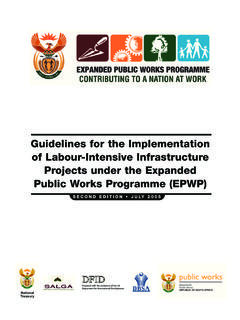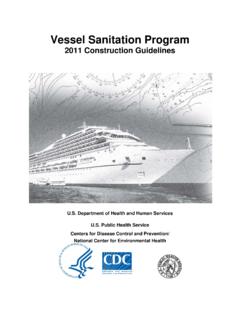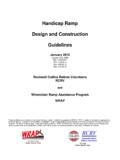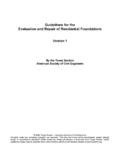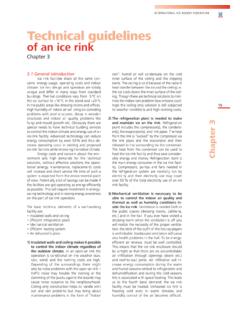Transcription of Guidelines for the Implementation of Labour …
1 Guidelines for the Implementation of Labour -Intensive InfrastructureProjects under the ExpandedPublic Works Programme (EPWP)Prepared with the assistance of the UKDepartment for International DevelopmentNational TreasurySECOND EDITION JULY 2005 Guidelines for the Implementation of Labour Intensive Projects under the Expanded Public Works Programme (EPWP)Table of contentsForewordITerminologyIIIA bbreviationsIII1. Introduction12. Responsibilities of the public Selection of Setting of rate of Appointment of consulting engineers and contractors33 Contract Documentation for Consulting Engineers and Contractors for Labour intensive construction Contract Documentation for Consulting Engineering Contract Documentation for the Conditions of Conditions of Scope of Schedules of quantities194 Design checklist20 APPENDIX A: SOURCES OF ADDITIONAL INFORMATION21 APPENDIX B: TYPES OF INFRASTRUCTURE WHICH ARE SUITABLE FOR CONSTRUCTION USING Labour INTENSIVE Haul of Houses, schools and clinics25 APPENDIX C: REQUIRED SKILLS Contractors26 APPENDIX D.
2 Definitions of programme indicators 27 Second Edition July 2005 ForewordThe Expanded Public Works Programme (EPWP) is one of government s short-to-medium termprogrammes aimed at alleviating and reducing unemployment. The EPWP will achieve this aimthrough the provision of work opportunities coupled with training. It is a national programmecovering all spheres of government and state-owned enterprises (SOE s). President Mbeki formally announced the programme in his State of the Nation Address in February s medium-to-long term programmes to address unemployment include increasingeconomic growth, improving skills levels through education and training, and improving theenabling environment for industry to flourish. The EPWP will continue to exist until thesemedium-to-long term programmes are successful in reducing unemployment.
3 The programme involves reorientating line function budgets so that government expenditureresults in more work opportunities, particularly for unskilled Labour . EPWP projects will thereforebe funded through the normal budgetary process, through the budgets of line-function departments, provinces and for implementing the EPWP have been identified in the infrastructure, environmental,social and economic sectors. In the infrastructure sector the emphasis is on creating additionalwork opportunities through the introduction of Labour -intensive construction methods. Labour -intensive construction methods involve the use of an appropriate mix of Labour and machines, witha preference for Labour where technically and economically feasible, without compromising thequality of the public bodies involved in infrastructure provision are expected to attempt to contribute to theprogramme.
4 As part of this initiative, the national government has through the 2004 Division ofRevenue Act placed some additional conditionalities on the Provincial Infrastructure Grant (PIG)and the Municipal Infrastructure Grant (MIG). These additional conditionalities will requireprovinces and municipalities to use the " Guidelines for the Implementation of Labour intensiveinfrastructure projects under the EPWP" agreed upon between SALGA, National Treasury andthe Department of Public Works for identification, design and construction or projects financedthrough the MIG or PIG. This document contains those and local experience has shown that, with well-trained supervisory staff and anappropriate employment framework, Labour -intensive methods can be used successfully forinfrastructure projects involving low-volume roads and sidewalks, stormwater drains, andtrenches.
5 On the basis of this experience, and in the context of high levels of unemployment,the national government has decided to require that these infrastructure projects must becarried out Labour -intensively. These Guidelines aim to provide provinces and municipalities with the necessary tools to successfully tender these projects as Labour -intensive projects. These Guidelines have beendesigned with the aim of minimising the additional work required from provincial and municipalofficials. The National Department of Public Works is working with the Construction Educationand Training Authority (CETA) to develop the capacity of the construction industry to design andmanage Labour -intensive infrastructure projects successfully.
6 ISecond Edition July 2005 The Guidelines contain sections which should be copied into the relevant parts of the contractdocumentation for consulting engineers and contractors. These sections introduce a requirementthat certain construction activities must be carried out by hand, under certain requirements were formulated on the basis of a thorough review of international andlocal experience of Labour -intensive construction, in order to identify the activities for whichit is economically and technically feasible to use Labour -intensive methods. The guidelinestherefore conform to the Public Finance Management Act requirement for assessing thecost-effectiveness of capital projects. The normal tender evaluation processes are followedunder these Guidelines , and it is not necessary to apply any special additional preferencesfor employment creation.
7 The Guidelines include the contents of the Code of Good Practice for Special Public WorksProgrammes, which has been gazetted by the Department of Labour , and which provides forspecial conditions of employment for these EPWP projects. In terms of the Code of GoodPractice, the workers on these projects are entitled to formal training, which will be providedby training providers appointed (and funded) by the Department of Labour . For projects ofup to six months in duration, this training will cover life-skills and information about othereducation, training, and employment order to develop the capacity of the construction industry to manage Labour -intensiveprojects, these Guidelines also include an eligibility requirement for the appointment of contractors and consulting engineers, that their key staff involved in the project mustundergo special NQF-accredited training programmes in Labour -intensive construction.
8 As an additional means of addressing the capacity in the Labour -intensive construction sector,DPW together with the CETA has established a Labour intensive contractor learnership programme. The aim of this learnership programme is to produce small contractors qualified to execute work in accordance with these Guidelines . The CETA is paying for the classroom training of these part of this learnership programme, learner contractors need to execute projects to gainpractical experience. Partnering provinces and municipalities may allocate projects identifiedand designed using these Guidelines to the learner contractors on a negotiated price basis. An electronic version of these Guidelines and electronic copies of the following documents canbe obtained on the enclosed CD ROM or downloaded from.
9 Code of Good Practice for Employment and Conditions of Work for Special Public WorksProgrammes Ministerial Determination, Special Public Works Programmes, issued in terms of the BasicConditions of Employment Act of 1997 by the Minister of Labour in Government Notice N R63 of 25 January 2002 Government Gazette (DORA 2004 with MIG and PIG Conditions) Documents relating to the Labour Intensive Contractor Learnership ProgrammeIISecond Edition July 2005 Amendments to the first edition incorporated in this second editionMinor amendments to the text of the first edition have been made to:i) change the deadlines for persons in the employ of the contractor to be accredited in respectof the relevant CETA standards;ii) align the text with the requirements of the Construction Industry Development Regulations;andiii) delete text that has now become By hand:refers to the use of tools which are manually operated and poweredForm of contract:refers to a document (conditions of contract) published by industry whichestablishes the rights, liabilities and obligations of the contracting parties and the proceduresfor the administration of the contract.
10 Labour -intensive:refers to methods of construction involving a mix of machines and Labour ,where Labour , utilising hand tools and light plant and equipment, is preferred to the use of heavymachines, where technically and economically feasible.(Note: The normal emphasis on the cost-effectiveness and quality of the asset must beretained.)Public body: refers to a department, trading entity, constitutional institution, municipality, publicentity or municipal entityScope of work:refers to a specification and description of the services or construction workswhich are to be provided and any other requirements and constraints relating to the manner inwhich the contract is to be performedAbbreviationsCETA:Construction Education and Training AuthorityCIDB:Construction Industry Development BoardECSA:Engineering Council of South AfricaEPWP:Expanded Public Works ProgrammeFIDIC:French acronym for the International Federation of Consulting EngineersNEC:New Engineering ContractNQF:National Qualifications FrameworkSANS:South African National StandardSPWP.

